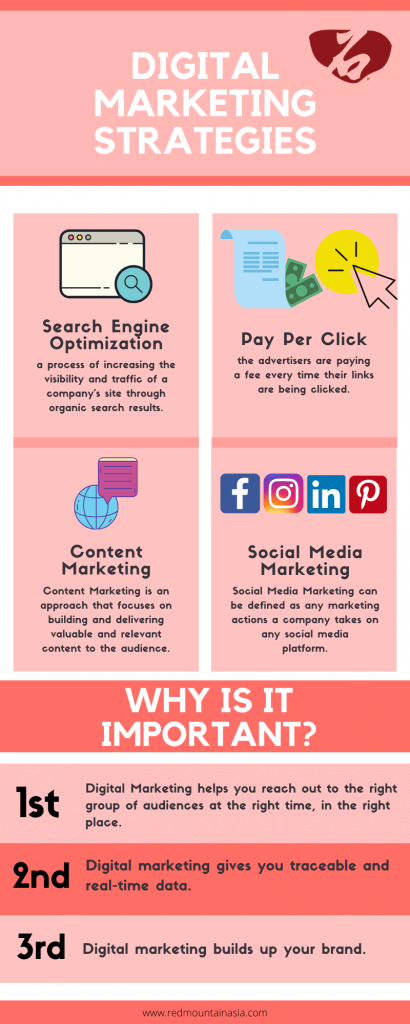What is Digital Marketing? | Best Digital Marketing Strategies | Explained
PoliticMag Press Release : September 15, 2020
What is Digital Marketing?
Yes, we know you’ve heard enough this term. But, what exactly is Digital Marketing?
By definition, Digital Marketing is an online marketing effort a company spends to promote its brand, sell its products and services, and get engaged with its audience.
In other words, Digital Marketing is basically marketing… Well, just on a different platform, a BIGGER platform.
Nowadays, it is almost unimaginable what the world would be like without the internet. Everyone goes online; no matter you want to shop, do research, or connect with people, the first thing you grab is either your phone or your laptop. In fact, statistics have shown that the world is gaining a constant increase in online usage. According to a recent study conducted by Statista, the global digital population of active internet users as of July 2020 was 4.57 billion people, which accounted for 60% of the global population, with China, India, and the United States ranking the highest among all countries. More surprisingly, Pew Research Center has revealed that in the United States, almost 8 in every 10 adults go online at least daily and there is also a rising rate of 9% among young adults aged between 18 to 29 years old.
What all the mind-blowing data here is telling us, is that people rely heavily on the internet. When a majority of the population is active in the online community, it is natural for businesses to have the urge to get involved in that community, hence explains the newsletter emails, online shopping portals, and social media engagements you often receive.
Under the big umbrella of digital marketing, there is a term called The Digital Marketing Trifecta, which encompasses the 3 critical channels: Owned, Paid, and Earned Media.
Owned Media
Well, just as straightforward as it sounds, owned media simply means the channels and assets a company owns. Company websites, social media pages, blogs, infographics, ebooks, or any other sorts of content a company creates are all categorized as owned media.
Owned media is remarkably valuable to every business as it symbolizes the presence of the company’s brand. With owned media, a company has its full control over conversion. That means the greater the presence, the more attention from the audience the business attracts. In other words, the more owned media the better. However, you should keep in mind that managing owned media is an ongoing task; it requires commitment, intention, and effort. It showcases a company’s characteristics and attitude, and therefore, any information or content shared on owned media should drive a positive value to the audience.
Paid Media
Paid Media is when you put money on a third-party platform to gain leverage for your own brand or to generate traffic to your owned media. Any channel or asset that involves a monetized value can be defined as paid media, like Facebook Ads, commercials, or paid search ads. Sponsorship-related or influencer-related actions can also be described as paid media.
Paid Media can be impactful to a company when implemented strategically, as it helps a company reach a certain targeted audience. That being said, paid media can be tricky in the present day as more people are learning ways to block unwanted advertisements. As paid media is counted as a cost, a company should ensure that the money invested on the paid platform is worthy and practical to support the overall marketing goals of the business.
Earned Media
If there is one thing that distinguishes among earned media and the other two, it’s that earned media is solely based on customers. That is, customers are the company’s advertising channel – through reviews, comments, referrals, or sharing on social media pages, these actions are word-of-mouth recommendations. When a positive brand is established, there is even a chance that a company can attract potential online influencers to promote its products or services voluntarily.
Earned Media is a dignified asset to any company as it is merely built up by the brand’s supportive and loyal customers. Yet, when a company exposes itself on the internet, it also implies that negative comments or backfires might result. But don’t panic! This is exactly the time for you to show your extraordinary customer service skills – turning a “nay” into a “yay” by resolving disputes and convincing the customers that they should stay!
What are the most effective digital marketing strategies?
Okay, now that we are ready, let’s talk digital marketing strategies.
There are numerous digital strategies in the market and each of them has a different function. This time, I will share with you what strategies the major-league companies are using for digital marketing.
(1) Search Engine Optimization
SEO, also known as Search Engine Optimization which is one of the branch of Search Engine Marketing, is a process of increasing the visibility and traffic of a company’s site through organic search results. When you search for something on a search engine and it shows 100+ pages of search results, have you ever wondered why the first-page results are on the first page?
Well, on every search engine, there are bots that go out there to crawl pages and gather information from site to site. These bots then come back and put everything into an index. After that, the algorithm analyzes the pages and ranks the data and factors to decide the page sequence in regards to a given query. There are actually many factors that would affect the sequence and I am not going to get into the advanced science here. But in general, a website’s content quality, keyword search, crawlability, and mobile-friendliness are some major factors that have a significant impact on its search engine ranking.
Keep in mind that SEO is tremendously important because you always want your company to appear at everyone’s first sight when they search for something. According to current statistics, approximately 93% of web traffics is from search engines and most people’s online process starts from there. With SEO, you ensure your company stays at the top of the rank before your competitors.
(2) Pay-Per-Click
PPC, or commonly known as Pay-per-click, is another model that falls under the category of Search Engine Marketing (SEM). Pay-per-click, just as it’s named, means that the advertisers are paying a fee every time their links are being clicked. Unlike SEO, it is rather inorganic because you are basically buying an audience to visit your website. However, PPC is still one of the most adopted strategies in the business world for a reason.
PPC strategies can be implemented on different online platforms. For example, one of the most popular platforms is the Search Engine Results Pages (SERPs). Let’s say when you search for something on Google, what you’ll realize is that the first couple of websites shown on the first page usually have the word “Ad” next to them. That is because those companies invested in Google Ads and made sure that when people type a certain keyword, their websites show up first. Besides search engines, businesses can also carry out PPC strategies on social media platforms like Facebook and Twitter.
Although PPC is seen as less organic, it doesn’t mean it’s useless. Pay-per-click is, in fact, a pretty helpful shortcut for companies when they want to engage with a specific group of people quickly. On search engines, paid ads are like an assurance of visibility to the audience who are typing a specific keyword. Similarly, companies paying ads on Facebook also have the ability to reach the right audience by choosing certain demographics, locations, and behaviors of users. In general, PPC is an effective tool to boost brand awareness, generate leads, and increase site traffic.
(3) Content Marketing
Besides SEM, Content Marketing is also of paramount importance to digital marketing. Content Marketing is an approach that focuses on building and delivering valuable and relevant content to the audience. The idea of content marketing is that, instead of being pushy and displaying all the products or services you have, you focus on providing consistent and proper content that helps build a trustworthy relationship with your prospective and existed audience. Companies can be creative when developing their content: infographics, original images, ebooks, blogs, or even case studies are some good examples of content marketing.
Remember, content marketing and SEO are interrelated and are almost complementary. To achieve SEO, you have to provide great content and resources on your website; correspondingly, when your website has high visibility on search engines, you want to make sure every visitor can obtain a valuable message and a positive experience from your website, thus brings a chance to turn them from prospects into customers.
(4) Social Media Marketing
Social Media Marketing is something that should not be missed at all because… who doesn’t go on social media nowadays? Generally speaking, Social Media Marketing can be defined as any marketing actions a company takes on any social media platform. According to a Hubspot study, the number one platform for digital marketers is Facebook. Not only did Facebook have 2.6 billion monthly active users as of the first quarter of 2020, but it also embodies over 80 million small businesses that use its free business tools for marketing purposes. What Instagram? The same study states that Instagram is a social platform with the 2nd highest ROI (Return of Investment) and that by 2023, Instagram expects itself to reach a total of 120.3 million monthly active users (just in the United States). Depending on the purpose, different marketers go active on different platforms. For B2B (Business-to-Business) marketers, LinkedIn is the 2nd most popular platform for them to connect with people.
Social Media Marketing is a great strategy because of the tremendous amount of active users on social media. Furthermore, social media allows businesses to create both original content and paid advertisements, which gives businesses flexibility on budgets and marketing goals.
(5) Email Marketing
Email Marketing is the process of sending direct mail to the targeted audiences in order to communicate the business promotions and various offerings. It is one of the widely used forms of marketing and has been in play for many years. Today email marketing has become an important strategy of digital marketing as it induces more personalization with the targeted audience. There are many email marketing service providers online today through which any marketer can automate their email campaign according to their requirements. Some of the email marketing service providers like Mail Chimp, Aweber are mostly used by many digital marketers these days.
Conclusion
As you can tell by now, digital marketing is very important in the business world. First and foremost, it helps companies reach out to the right group of audiences at the right time, in the right place. As we’ve mentioned a couple of times before, people enjoy going online. There are countless online platforms on the internet and different platforms encompass different audiences with different demographics, behaviors, and interests. For example, Pinterest tends to attract more female users than male users, and Instagram intrigues a majority of young adult users. No matter paid or organic, any digital marketing content created by your company has the power to convey a message to your targeted audience.
On top of that, digital marketing gives you traceable and real-time data. When you manage a website or a social page, you can always attain the analytical information like site traffic, engagement, impression, and followers, etc. The data also keep you updated on your audience’s activities like their most active time in a day, or demographics like their locations and number of users of different gender, etc.
The analytical data on digital marketing is crucial to a company because it allows you to measure the ROI (Return of Investment), make forecasts, and adjust your marketing strategies, budgets, and goals.
Lastly, digital marketing builds up your brand. With all the owned, paid, and earned media channels as well as the marketing strategies we’ve talked before, you are basically presenting who you are as a company and giving an impression to your audience whether you care or not. Any online activity is a chance to engage with your audience – A blog tells a story, a new product shows your advancement, a statement affirms what your company values. Through engagements with your audience and the messages you send, you are gradually building your brand’s reputation and image.







